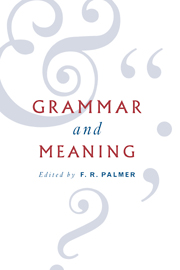Book contents
- Frontmatter
- Contents
- List of contributors
- Foreword
- 1 Polysemous relations
- 2 Fields, networks and vectors
- 3 Syntax, semantics, pragmatics
- 4 Natural-language interpretation as labelled natural deduction
- 5 Three levels of meaning
- 6 Does spoken language have sentences?
- 7 Grammaticalisation and social structure: non-standard conjunction-formation in East Anglian English
- 8 German Perfekt and Präteritum: speculations on meaning and interpretation
- 9 The possessed
- 10 Complement clauses and complementation strategies
- 11 Grammar and meaning
- John Lyons: publications
- Index
6 - Does spoken language have sentences?
Published online by Cambridge University Press: 30 January 2010
- Frontmatter
- Contents
- List of contributors
- Foreword
- 1 Polysemous relations
- 2 Fields, networks and vectors
- 3 Syntax, semantics, pragmatics
- 4 Natural-language interpretation as labelled natural deduction
- 5 Three levels of meaning
- 6 Does spoken language have sentences?
- 7 Grammaticalisation and social structure: non-standard conjunction-formation in East Anglian English
- 8 German Perfekt and Präteritum: speculations on meaning and interpretation
- 9 The possessed
- 10 Complement clauses and complementation strategies
- 11 Grammar and meaning
- John Lyons: publications
- Index
Summary
Introduction
Many linguists working on spoken language abandon the sentence as an analytic unit as a result of data like the text in (1), which is the transcription of a conversation. The ‘ + ’ signs mark brief pauses.
(1) I used to light up a cigarette + you see because that was a very quiet way to go + now when I lit up my cigarette I used to find myself at Churchill + and the quickest way to get back from Churchill was to walk along long down Clinton Road + along + Blackford something or other it's actually an extension of Dick Place but it's called Blackford something or other it shouldn't be it's miles away from Blackford Hill + but it's called Blackford Road I think + uhm then along to Lauder Road and down Lauder Road.
As Crystal (1987:94) observes about another, but similar, text, it is not easy to decide whether the pauses mark sentence boundaries or whether the whole text is one loosely constructed sentence. An additional problem in (1) is that one stretch uninterrupted by pauses appears to consist of what would be several sentences in writing: It's actually an extension of Dick Place, but it's called Blackford something or other, It shouldn't be, it's miles from Blackford Hill. Two of the clauses are conjoined by but, but two are simply adjacent to the preceding one.
- Type
- Chapter
- Information
- Grammar and MeaningEssays in Honour of Sir John Lyons, pp. 116 - 135Publisher: Cambridge University PressPrint publication year: 1995
- 13
- Cited by

